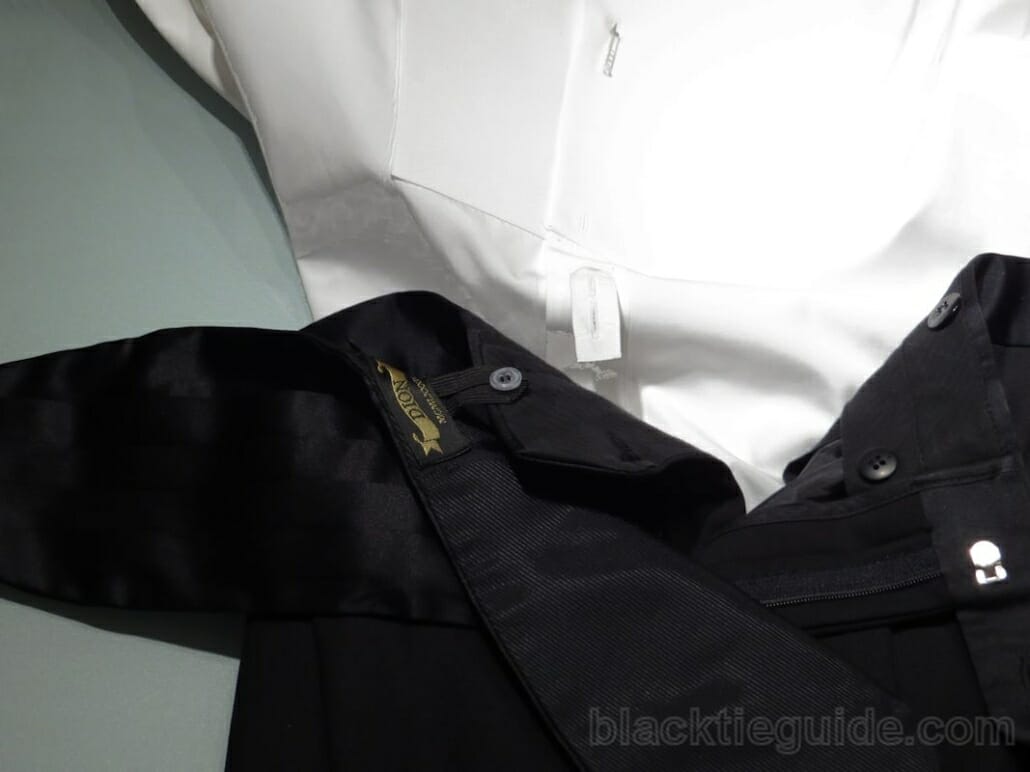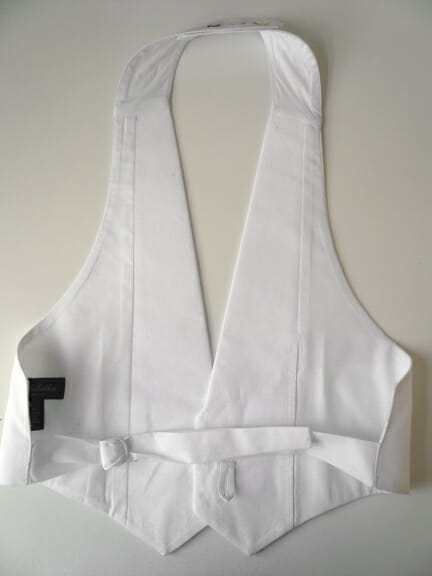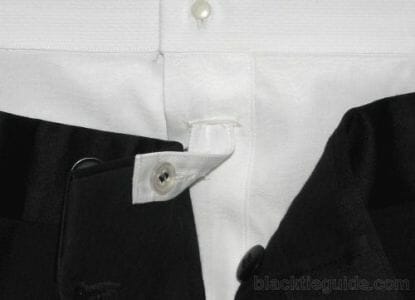Judging by the requests I receive for more details of the tabs on formal shirts and waist coverings I didn’t do a very good job of explaining this in the Guide. So here’s a close-up look at everything you wanted to know – or didn’t want to know – about this interesting example of formal engineering.
The practice of buttoning one’s shirtfront to one’s trousers to prevent it from riding up apparently became popular in the 1880s although I have found examples of tabs dating back to the 1860s. The appendage’s appearance on waist coverings goes back even further, debuting on evening and wedding waistcoats around 1840. Cummerbunds have been sporting tabs of their own since some of the earliest models were patented back in the mid-1920s. (See the Vintage section of the Guide for examples of all three.)
While this previously standard feature of fine formal wear is rare these days it is, fortunately, a simple matter to attach one to existing garments. Indeed, fabric tie-stays make a perfect substitute. You will also need a button inside the trouser waistband to hold the various tabs. Just bring your shirt, waist covering and trousers to a tailor or seamstress and he or she can determine where the button and/or tabs need to be placed in order to line up properly.*
Once you’ve got the parts in place it’s time to get dressed:

- Put on your shirt and trousers leaving the trousers undone.
- If wearing a waistcoat, put it on with the neck strap fastened but not the back strap (this will allow more manoeuvrability in the next step)
- Attach the waist covering tab to the trouser first. (The tab is found on the reverse side of the covering, near the top of a cummerbund and near the bottom of a waistcoat.)
- Attach the shirt tab to the trouser, thus sandwiching the waistband between the inner layer of the shirt and the outer layer of the trousers.
- Fasten the trousers.
- Fasten the waist covering behind your back as usual and voilà, you’re done.
Like suspenders, these tabs may seem fussy when getting dressed but once you’ve suited up you can rest easy knowing that the waist of your outfit will remain perfectly in place throughout the evening. (Admittedly, also like suspenders, they add a little extra fidgeting when answering the call of nature.)

________________________________________
Postscript: DIY Tips
February 11, 2014
My recent experience with a new tailor and a new three-piece tuxedo has shown me that this sort of alteration is not within the pervu of the typical tailor or seamstress. Here are some helpful hints you may want to share with them:
- with the shirt and trousers on, pin the shirt tab to the shirt and use this to determine the position of the corresponding trouser button.
- it is okay for the shirt tab to be attached above the waistline as you’ll be covering it with a cummerbund or waistcoat; just make sure it’s aligned with the buttons on the shirt
- the horizontal positioning of the shirt tab button should align with the fly as that is the center line of the trousers; its vertical positioning will depend on the positioning of the buttonhole in the shirt tab but generally speaking it shouldn’t be too far below the waistband because it will ideally be used to also fasten the waist covering
- use a shirt button instead of a larger trouser button as it will fit more easily into the eyelet in the shirt tab
- the cummerbund tab should be an elastic loop and be positioned in the center of the cummerbund at a height that allows it to attach to the same button used for the shirt tab (there’s much more leeway here as the elastic tab will stretch, unlike the shirt tab)
- generally, the cummerbund’s vertical centerline is at the same height as the trouser waistband; if it sits too low it may expose the bottom of the shirt bib (and possibly the working button and shirt tab below that), if it sits too high it may give the impression that your pants are hiked up to your chest
- the waistcoat tab should also be elastic and also positioned to attach to the same button as used for the shirt (I noticed that Brooks Brothers full-dress waistcoats have the tab set slightly to the left of the vest’s center line (when viewed from the front) which requires a second similarly off-center button be added to the trouser waistband. However, I don’t understand the benefit of this asymmetrical alignment.)
- generally, the evening waistcoat’s center button sits at the same height as the trouser waistband

How fascinating! Some fabulous tips too, finally I can look totally smart…
Very helpful. Your information is hard to find, and very worthwhile to know for the guy who can’t find the perfect products, but is handy with tools…in this case a sewing machine. Thanks for the input.
This is spot on, thank you!
Very hard to adjust one button to work perfectly for both cummerbund and shirt, especially if you have more than one combo of possible shirt/cover/trousers, so I suggest using separate buttons as follows.
The shirt tab must go through a button hole, and even if it has two boutonnieres (as depicted) there is not much choice, and the tab ends fairly low. So one can have a few shirt buttons sewn along the line of the lining that marks the fly and hopefully one will match the shirt tab of the day.
For the cummerbund tab one can use the button that already exists on the inside of the waistband that is used to close the waistband from inside (first button of the 3 needed to close the waistband). This is slightly to the left so it explains BB’s style. Alternatively one can use the button that already exist just above the fly on the outside of the waistband (this is centered). However some trousers use clasps rather than this button (o tempora, o mores :-)) so BB does the right thing.
Sorry I don’t know either the correct names for all these parts or how to insert a picture in a comment but I hope the idea is clear.
— Gaius
The 4 button, straight edge, horseshoe waistcoat (vest) of my evening suit has two waistband tabs. These are placed to match the two inner front braces (suspenders) buttons on the trousers.
(When dressing they are attached before / in front of the braces themselves)
The benefit is that the “pull” through the waistcoat is transferred through the shoulders and does not distort the shape of either trouser or waistcoat in the way an over-tight central tab sometimes can.